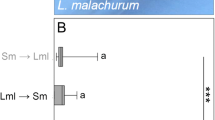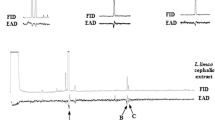Abstract
The parasitoid beetle Metoecus paradoxus frequently parasitizes colonies of the common wasp, Vespula vulgaris. It penetrates a host colony as a larva that attaches itself onto a foraging wasp’s body and, once inside the nest, it feeds on a wasp larva inside a brood cell and then pupates. Avoiding detection by the wasp host is crucial when the beetle emerges. Here, we tested whether adult M. paradoxus beetles avoid detection by mimicking the cuticular hydrocarbon profile of their host. The beetles appear to be chemically adapted to their main host species, the common wasp, because they share more hydrocarbon compounds with it than they do with the related German wasp, V. germanica. In addition, aggression tests showed that adult beetles were attacked less by common wasp workers than by German wasp workers. Our results further indicated that the host-specific compounds were, at least partially, produced through recycling of the prey’s hydrocarbons, and were not acquired through contact with the adult host. Moreover, the chemical profile of the beetles shows overproduction of the wasp queen pheromone, nonacosane (n-C29), suggesting that beetles might mimic the queen’s pheromonal bouquet.




Similar content being viewed by others
References
Aitchison J (1986) The statistical analysis of compositional data. The Blackburn Press, Caldwell
Akino T, Knapp JJ, Thomas JA, Elmes GW (1999) Chemical mimicry and host specificity in the butterfly Maculinea rebeli, a social parasite of Myrmica ant colonies. Proc R Soc B 266:1419
Akino T, Yamamura K, Wakamura S, Yamaoka R (2004) Direct behavioral evidence for hydrocarbons as nestmate recognition cues in Formica japonica (Hymenoptera: Formicidae). Appl Entomol Zool 39:381–387
Bagnères A-G, Lorenzi MC (2010) Chemical deception/mimicry using cuticular hydrocarbons. In: Bagnères A-G, Blomquist GJ (eds) Insect hydrocarbons: biology, biochemistry, and chemical ecology. Cambridge University Press, Cambridge, pp 282–324
Bates D, Maechler M, Bolker B, Walker S (2015) Fitting linear mixed-effects models using lme4. J Stat Softw 67(1):1–48
Carl, KP, Wagner, A (1982) Investigations on Sphecophaga vesparum Curtis (Ichneumonidae) and Metoecus paradoxus L.(Rhipiphoidae) for the biological control of Vespula germanica F. (Vespidae) in New Zealand. Silwood Park, Commonwealth Institute of Biological control, Working Report, UK
Dani FR, Jones GR, Destri S, Spencer SH, Turillazzi S (2001) Deciphering the recognition signature within the cuticular chemical profile of paper wasps. Anim Behav 62:165–171
Dettner K, Liepert C (1994) Chemical mimicry and camouflage. Annu Rev Entomol 39:129–154
d’Ettorre P, Errard C, Ibarra F, Francke W, Hefetz A (2000) Sneak in or repel your enemy: Dufour’s gland repellent as a strategy for sucessful usurpation in the slave-maker Polyergus rufescens. Chemoecology 10:135–142
R Development Core Team (2011) R: a language and environment for statistical computing. Vienna, Austria
Edwards, R (1980) Social wasps. Their biology and control. Rentokil Ltd
Elgar MA, Allan RA (2004) Predatory spider mimics acquire colony-specific cuticular hydrocarbons from their ant model prey. Naturwissenschaften 91:143–147
Gamboa GJ (2004) Kin recognition in eusocial wasps. Ann Zool Fenn 41:789–808
Guerrieri FJ, Nehring V, Jørgensen CG, Nielsen J, Galizia CG, d’Ettorre P (2009) Ants recognize foes and not friends. Proc R Soc B 276:2461–2468
Halang WA, Langlais R, Kugler E (1978) Cubic spline interpolation for the calculation of retention indices in temperature-programmed gas–liquid chromatography. Anal Chem 50:1829–1832
Heitmans WRB, Peeters TMJ (1996) Metoecus paradoxus in The Netherlands (Coleoptera: Rhipiphoridae). Entomologische Berichten 56:109–117
Howard RW, Blomquist GJ (2005) Ecological, behavioral, and biochemical aspects of insect hydrocarbons. Annu Rev Entomol 50:371–393
Howard RW, McDaniel CA, Blomquist GJ (1980) Chemical mimicry as an integrating mechanism: cuticular hydrocarbons of a termitophile and its host. Science 210:431–433
Howard RW, Stanley-Samuelson DW, Akre RD (1990) Biosynthesis and chemical mimicry of cuticular hydrocarbons from the obligate predator, Microdon albicomatus Novak (Diptera: Syrphidae) and its ant prey, Myrmica incompleta Provancher (Hymenoptera: Formicidae). J Kans Entomol Soc 63:437–443
Kather R, Drijfhout FP, Shemilt S, Martin SJ (2015) Evidence for passive chemical camouflage in the parasitic mite Varroa destructor. J Chem Ecol 41:178–186
Lenoir A, Fresneau D, Errard C, Hefetz A (1999) Individuality and colonial identity in ants: the emergence of the social representation concept. In: Detrain C, Deneubourg J-L, Pasteels JM (eds) Information processing in social insects. Birkhäuser Verlag, Basel, pp 219–237
Lenoir A, d’Ettorre P, Errard C, Hefetz A (2001) Chemical ecology and social parasitism in ants. Annu Rev Entomol 46:573–599
Lorenzi M, Bagnères A (2002) Concealing identity and mimicking hosts: a dual chemical strategy for a single social parasite? (Polistes atrimandibularis, hymenoptera: vespidae). Parasitology 125:507–512
Lorenzi MC, Bagnères A-G, Clement J-L (1996) The role of cuticular hydrocarbons in social insects: Is it the same in paper-wasps? In: Turillazzi S, West-Eberhard MJ (eds) Natural history and evolution of paper wasps. Oxford University Press, Oxford, pp 178–189
Martin SJ, Carruthers JM, Williams PH, Drijfhout FP (2010) Host specific social parasites (Psithyrus) indicate chemical recognition system in bumblebees. J Chem Ecol 36:855–863
Messadi D, Helaimia F, Ali-Mokhnache S, Boumahraz M (1990) Accurate determination of retention indices in programmed temperature gas chromatography. Chromatographia 29:429–434
Nash DR, Boomsma JJ (2008) Communication between hosts and social parasites. In: d’Ettorre P, Hughes DP (eds) Sociobiology of communication: an interdisciplinary perspective. Oxford University Press, Oxford, pp 55–79
Singer TL (1998) Roles of hydrocarbons in the recognition systems of insects. Am Zool 38:394–405
Soroker V, Vienne C, Hefetz A (1995) Hydrocarbon dynamics within and between nestmates in Cataglyphis niger (Hymenoptera: Formicidae). J Chem Ecol 21:365–378
Spradbery JP (1973) Wasps. An account of the biology and natural history of social and solitary wasps, with particular reference to those of the British Isles. Sidgwick & Jackson, London
Van Oystaeyen A, Oliveira RC, Holman L, van Zweden JS, Romero C, Oi CA, d’Ettorre P, Khalesi M, Billen J, Wäckers F, Millar JG, Wenseleers T (2014) Conserved class of queen pheromones stops social insect workers from reproducing. Science 342:287–290
van Zweden JS, d’Ettorre P (2010) Nestmate recognition in social insects and the role of hydrocarbons. In: Blomquist GJ, Bagnères A-G (eds) Insect hydrocarbons: Biology, biochemistry and chemical ecology. Cambridge University Press, Cambridge, pp 222–243
van Zweden JS, Brask JB, Christensen JH, Boomsma JJ, Linksvayer TA, d’Ettorre P (2010) Blending of heritable recognition cues among ant nestmates creates distinct colony gestalt odours but prevents within-colony nepotism. J Evol Biol 23:1498–1508
Vander Meer RK, Wojcik DP (1982) Chemical mimicry in the myrmecophilous beetle Myrmecaphodius excavaticollis. Science 218:806–808
Wossler TC (2002) Pheromone mimicry by Apis mellifera capensis social parasites leads to reproductive anarchy in host Apis mellifera scutellata colonies. Apidologie 33:139–163
Acknowledgments
AVO, HH, and TW were supported by Research Foundation Flanders (FWO) and the KU Leuven Centre of Excellence PF/2010/007, JSvZ was supported by a postdoctoral fellowship of FWO (grant 12Q7615N).
Author Contributions
AVO, HH, WB and TW designed the experiments. AVO and HH collected wasp nests and carried out experiments. AVO, JSvZ, HH and FD analyzed the data. AVO, JSvZ, and TW wrote the manuscript.
Author information
Authors and Affiliations
Corresponding authors
Additional information
Annette Van Oystaeyen and Jelle S. van Zweden contributed equally to this work.
Rights and permissions
About this article
Cite this article
Van Oystaeyen, A., van Zweden, J.S., Huyghe, H. et al. Chemical Strategies of the Beetle Metoecus Paradoxus, Social Parasite of the Wasp Vespula Vulgaris . J Chem Ecol 41, 1137–1147 (2015). https://doi.org/10.1007/s10886-015-0652-0
Received:
Revised:
Accepted:
Published:
Issue Date:
DOI: https://doi.org/10.1007/s10886-015-0652-0




